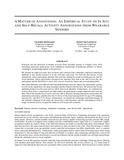Zitierlink:
10.3389/fcomp.2024.1379788Dateien zu dieser Ressource:
| Datei | Beschreibung | Größe | Format | |
|---|---|---|---|---|
| A_matter_of_annotation.pdf | 2.36 MB | Adobe PDF |  Öffnen/Anzeigen |
| Dokumentart: | Article | Titel: | A matter of annotation: an empirical study on in situ and self-recall activity annotations from wearable sensors | AutorInn(en): | Hölzemann, Alexander Van Laerhoven, Kristof |
Institut: | Department Elektrotechnik - Informatik | Schlagwörter: | Data annotation ambiguity, Data labeling, Deep learning, Dataset, Annotation method, Mehrdeutigkeit von Datenkommentaren, Datenbeschriftung, Tiefes Lernen, Datensatz, Annotationsmethode | DDC-Sachgruppe: | 004 Informatik | Erscheinungsjahr: | 2024 | Publikationsjahr: | 2024 | Auch erschienen: | Frontiers in computer science ; Vol. 6, 1379788. - https://doi.org/10.3389/fcomp.2024.1379788 | Zusammenfassung: | Research into the detection of human activities from wearable sensors is a highly active field, benefiting numerous applications, from ambulatory monitoring of healthcare patients via fitness coaching to streamlining manual work processes. We present an empirical study that evaluates and contrasts four commonly employed annotation methods in user studies focused on in-thewild data collection. For both the user-driven, in situ annotations, where participants annotate their activities during the actual recording process, and the recall methods, where participants retrospectively annotate their data at the end of each day, the participants had the flexibility to select their own set of activity classes and corresponding labels. Our study illustrates that different labeling methodologies directly impact the annotations' quality, as well as the capabilities of a deep learning classifier trained with the data. We noticed that in situ methods produce less but more precise labels than recall methods. Furthermore, we combined an activity diary with a visualization tool that enables the participant to inspect and label their activity data. Due to the introduction of such a tool were able to decrease missing annotations and increase the annotation consistency, and therefore the F1-Score of the deep learning model by up to 8% (ranging between 82.1 and 90.4 % F1-Score). Furthermore, we discuss the advantages and disadvantages of the methods compared in our study, the biases they could introduce, and the consequences of their usage on human activity recognition studies as well as possible solutions. |
Beschreibung: | Finanziert aus dem DFG-geförderten Open-Access-Publikationsfonds der Universität Siegen für Zeitschriftenartikel |
DOI: | 10.3389/fcomp.2024.1379788 | URN: | urn:nbn:de:hbz:467-27652 | URI: | https://dspace.ub.uni-siegen.de/handle/ubsi/2765 | Lizenz: | http://creativecommons.org/licenses/by/4.0/ |
| Enthalten in den Sammlungen: | Geförderte Open-Access-Publikationen |
Diese Ressource ist urheberrechtlich geschützt. |
Seitenansichten
109
checked on 25.12.2024
Download(s)
28
checked on 25.12.2024
Google ScholarTM
Prüfe
Prüfe
Diese Ressource wurde unter folgender Copyright-Bestimmung veröffentlicht: Lizenz von Creative Commons


